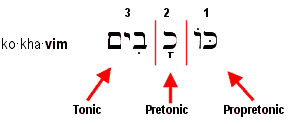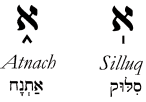|
|
||||||||||||||||||||||
 |
||||||||||||||||||||||
|
Learn Hebrew |
||||||||||||||||||||||
 |
||||||||||||||||||||||
|
Audio Tanakh |
||||||||||||||||||||||
 |
||||||||||||||||||||||
|
Hebrew Training |
||||||||||||||||||||||
|
|
|
||||||||||||||||
|
Most Hebrew words are generally accented on the last syllable of the word: |
|
However, some words (segolate nouns, furtive patach nouns, certain verb forms) accent the next to last syllable. In the vocabulary sections of the units, I will indicate non-standard accents by using the symbol "<" above the accented syllable: |
||||||
 |
||||||
|
Syllable (Phonetic) Classification |
||||||
 |
||||||
|
The "tonic" syllable is the syllable that receives the stress or accent; the "pretonic" syllable is the syllable before the tonic syllable, and the "propretonic" syllable is the syllable before the pretonic. Don't let this nomenclature intimidate you: in the Scriptures, accented syllables are usually identified with one or more accent marks (see below).
Disjunctive Accents
Conjunctive Accents
The following shows Genesis 1:1 as you might see it in a typical Masoretic text: |
||||||
 |
|
Note: You do not need to memorize the names of these accent marks; however, when you see one of them in your reading of the Tanakh, accent the syllable where the mark appears (for example, the silluq in the last word of the pasuk (verse) tells us to accent the pretonic syllable: ha-a-rets).
Note: You may also be interested in Helmut Richter's article regarding Hebrew Cantillation marks (special accent tags used for chanting the Torah).
|
|||||||||
|
Hebrew for Christians |
|||||||||
|
|||||||||

